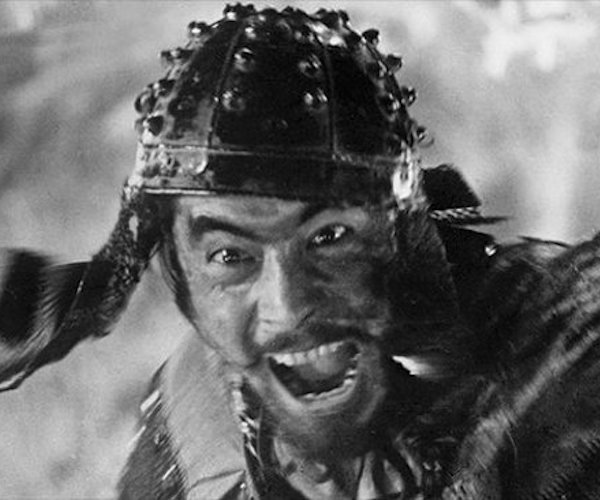Film Review: A Perfunctory Documentary on Toshiro Mifune
Legendary actor Toshiro Mifune could be less a stoic ronin, more a silly Jerry Lewis.
Mifune: The Last Samurai, directed by Steven Okazaki. Screening at the Kendall Square Cinema, Cambridge, MA.

Toshiro Mifune in “The Seventh Samurai.”
By Gerald Peary
Why in the world was Toshiro Mifune, the great star of Japanese cinema, in attendance at the 1985 Montreal World Film Festival? Whatever the reason, I got the once-in-a-lifetime opportunity to meet him there and to interview him. How rare was that? To this day, I have never encountered anyone else who has talked to him. And the rather perfunctory new film biography, Steven Okazaki’s Mifune: The Last Samurai, is remarkable for not offering a single filmed Q&A with the late actor, who died in 1997. (Or a Q&A either with filmmaker Akira Kurosawa, who died in 1998, his key collaborator.)
Too bad there was no camera in the hotel room where we spoke. As I reported in 1985 for Toronto’s Globe and Mail, “Throughout our interview, Mifune, 65, is as excited as a hyperactive juvenile, jumping up from his seat, racing around his Montreal hotel room to punctuate his anecdotes, breaking into imaginary swordfights and samurai battles, and in general tiring out his poor Japanese-to-English translator, who simply can’t keep up with him.” That’s right: Mifune was less a stoic ronin, more a silly Jerry Lewis. “When I was young,” he declared, “I played old men’s roles. Now I’m a little boy.” In the documentary, many talking heads speak reverently of the actor. Only Steven Spielberg, who cast him in 1941, saw the goofy Mifune I saw. “I didn’t expect him to laugh as much as he did,” said Spielberg, who recalled that Toshiro would chortle at the end of every intense take.
The Last Samurai? True, Mifune did play lots of swordsmen, most notably in The Samurai Trilogy and in the Kurosawa classics, The Seven Samurai and Yojimbo. But he was usually a mongrel samurai, an undisciplined samurai, a wandering uncouth samurai missing an ascetic master. In The Seventh Samurai he is a fake samurai, an itchy, smelly, animalistic poseur who gets adopted by the real samurai like a rescue dog. The Wild Samurai? More accurate, for gonzo he was. We do learn in Mifune of his two great loves, fine cars and alcohol. The alcohol—whiskey and saki—led to smashed autos and drunken challenges to fight yakuza gangsters. At home, he would imbibe through dinner, then swing a sword about afterward, terrifying his children.
Mifune has an interesting first act, showing where the modern samurai genre originated via clips from silent Japanese “chanbara” films, these often based on kabuki plays but opening up for the cinema with astonishingly choreographed swordsplay. I wish as much care would have been taken with clips from Mifune films. Classic scenes from Rashomon, The Seven Samurai, Throne of Blood, and Yojimbo are shown, but many of Kurosawa’s finest with Mifune are skipped over entirely, including two majestic noirs, Stray Dog and High and Low.
As for the Mifune-Kurosawa collaboration, it’s barely explained. Surely someone has the inside story of why they stopped making movies together. Filmmaker Okazaki doesn’t have an explanation. He tries to push a feel-good narrative that Mifune was intensely loyal to Kurosawa even after they separated, as he was so grateful that Kurosawa had discovered him and made him a star. Hmmm. In my 1985 interview it was obvious that Mifune was more resentful of Kurasawa than he was dazzled by his director. Here’s what he gave me, a juicy anecdote not in the documentary, when I asked if he and Kurosawa ever quarreled:
“Yes, on Yojimbo,” he admitted. “One day Kurosawa said, ‘I won’t mention names, but the actors are late.’ I said, ‘What are you talking about? I’m the actor.’ Every day after that, when Kurosawa arrived, I would be there already, in costume and makeup from 6 a.m. I showed him.’
A quarter century after Yojimbo, the prideful Mifune was still smarting from the public humiliation, an insult to his dignity. “No matter how much I drank the night before,” Mifune said, “I never once was late on his films. But with Kurosawa, sometimes people are waiting, and he never shows up. The people go to his house, and he says, ‘I’m sorry. I don’t feel well today.’”
Regarding the above claim, Okazaki’s documentary is useful. Those who worked with Toshiro Mifune confirmed that he was always punctual getting to the set. Also, I learned something about the famous violent ending to Throne of Blood, the Japanese Macbeth. Those were real arrows piercing Mifune. They were shot by college students, and Kurosawa hadn’t bothered with insurance.
Gerald Peary is a retired film studies professor at Suffolk University, Boston, curator of the Boston University Cinematheque, and the general editor of the “Conversations with Filmmakers” series from the University Press of Mississippi. A critic for the late Boston Phoenix, he is the author of nine books on cinema, writer-director of the documentaries For the Love of Movies: the Story of American Film Criticism and Archie’s Betty, and a featured actor in the 2013 independent narrative Computer Chess.

So Mifune was involved in “smashed autos and drunken challenges to fight yakuza gangsters.” Really? Like, furreal?
In re Throne of Blood, you say: “Those were real arrows piercing Mifune. They were shot by college students, and Kurosawa hadn’t bothered with insurance.”
Including the one that pierced his throat?
There used to be a theater in Manhattan, the Bijou, devoted to Japanese cinema. I skipped many a college class to attend.
In my elementary way, I thought Mifune a Japanese analog to Brando. He was in some ways. They had equal force. Brando had more range.